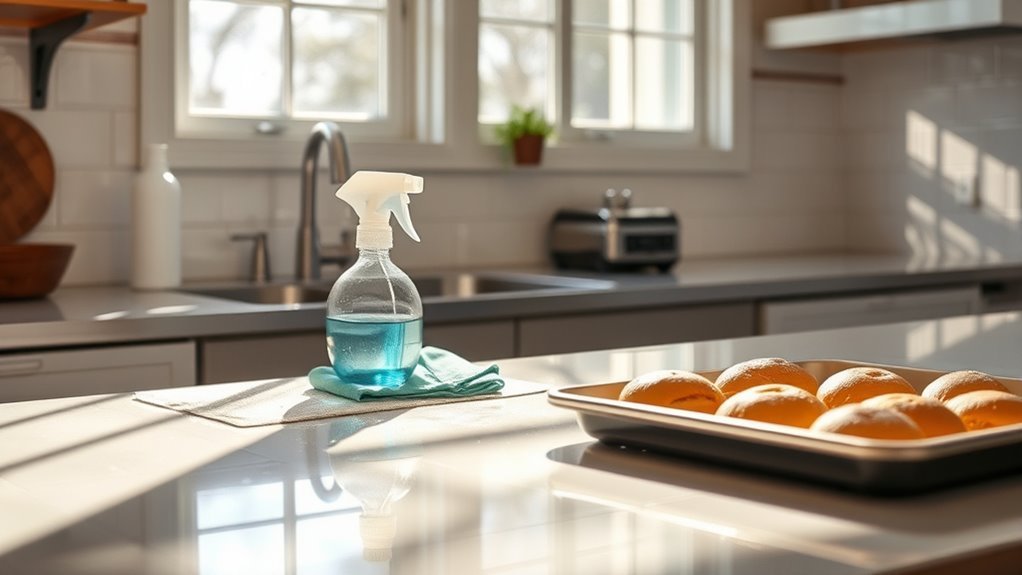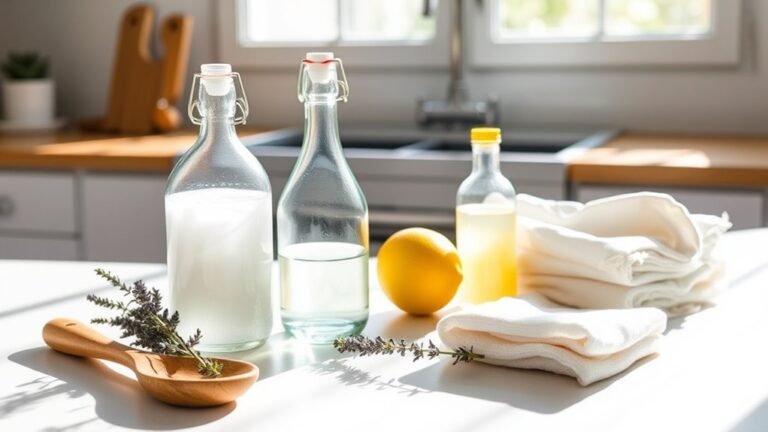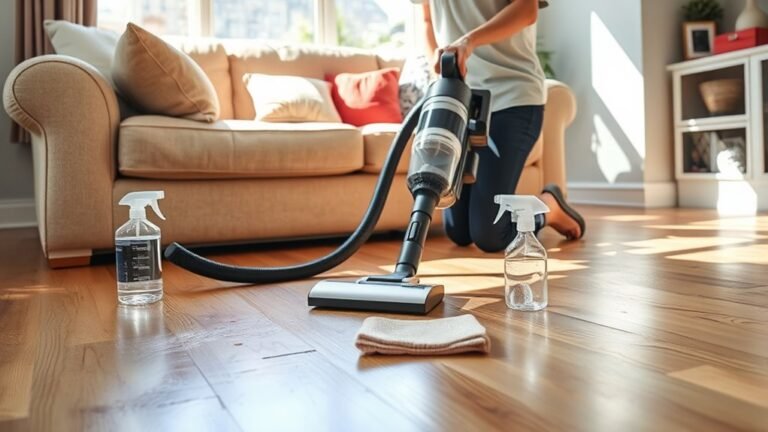Sanitizing a Home-Based Bakery for Safety
To sanitize your home-based bakery safely, start with durable gloves, microfiber cloths, and approved sanitizers. Clear surfaces, apply disinfectant, and let it sit before wiping. Wash hands thoroughly for 20 seconds and keep nails trimmed to prevent contamination. Store ingredients in airtight containers and refrigerate perishables promptly. Follow a daily and weekly cleaning schedule to keep everything spotless. If you stick to these hygiene steps, you’ll guarantee a cleaner, safer baking environment and can explore more detailed tips on effective sanitization.
Essential Cleaning Supplies for a Safe Bakery
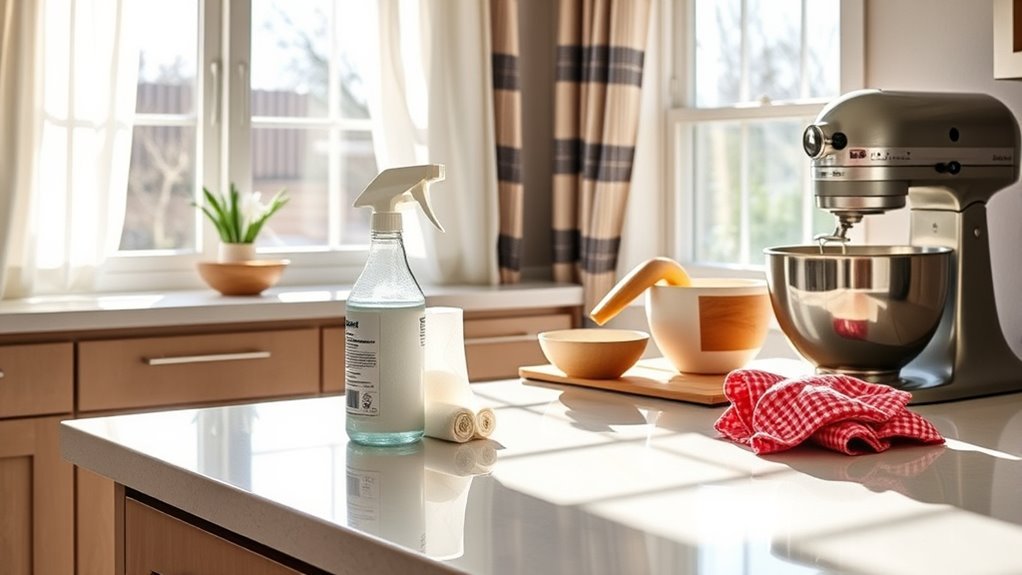
Keeping your home-based bakery safe starts with having the right cleaning supplies on hand. You’ll want to create a cleaning checklist that covers every surface and tool, ensuring nothing slips through the cracks. Essential items include durable gloves, microfiber cloths, and scrub brushes designed for thorough cleaning. Don’t forget effective sanitizing agents—choose those approved for food contact surfaces to keep your bakery hygienic without harsh residues. Having these supplies ready lets you tackle messes quickly, so you maintain a clean environment without disrupting your baking flow. By arming yourself with the right tools and a solid cleaning checklist, you’re protecting your freedom to bake confidently and safely, knowing your workspace meets health standards effortlessly.
Step-by-Step Guide to Sanitizing Surfaces and Equipment
Before you begin baking each day, you’ll want to thoroughly sanitize every surface and piece of equipment to guarantee your home-based bakery stays safe and clean. Start by clearing surfaces, then apply your chosen surface disinfectant techniques—spray, let sit, and wipe. For equipment sanitization procedures, disassemble removable parts and soak in sanitizer, then air dry. Always follow manufacturer guidelines to protect your tools and maintain freedom in your creative space.
| Schritt | Action | Tips |
|---|---|---|
| 1 | Clear surfaces | Remove crumbs and debris |
| 2 | Apply disinfectant | Use approved sanitizers |
| 3 | Wait and wipe | Follow contact time |
| 4 | Disassemble equipment | Separate parts for cleaning |
| 5 | Sanitize and air dry | Avoid towels to prevent germs |
Best Practices for Hand Hygiene and Personal Cleanliness
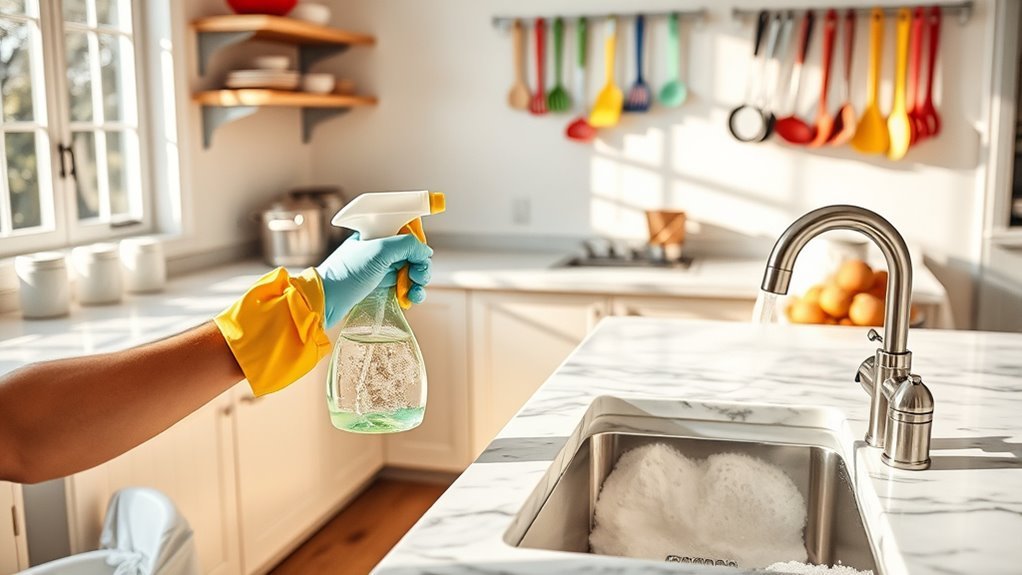
Sanitizing your surfaces and equipment lays the foundation for a safe baking environment, but your personal hygiene plays an equally important role in preventing contamination. You’ve got to master effective handwashing techniques and maintain consistent personal grooming to keep your bakery safe and your freedom intact.
Here are three best practices to follow:
- Wash your hands thoroughly with soap and warm water for at least 20 seconds, especially before and after handling food or touching your face.
- Keep nails trimmed and clean, avoiding nail polish or artificial nails that can harbor bacteria.
- Wear clean clothes and tie back hair to prevent stray strands or sweat from contaminating your baked goods.
Stick to these habits, and you’ll protect both your customers and your passion for baking.
Proper Storage and Handling of Ingredients
Though it might seem straightforward, how you store and handle your ingredients greatly impacts the quality and safety of your baked goods. You’ll want to check ingredient expiration dates regularly and use airtight storage containers to keep freshness locked in and pests out. Store dry goods in cool, dry places, and keep perishable items refrigerated promptly. Always handle ingredients with clean hands or utensils to avoid contamination.
| Ingredient Type | Storage Tips |
|---|---|
| Flour | Airtight containers, cool |
| Sugar | Sealed containers, dry place |
| Dairy | Refrigerate, check expiration |
| Nuts | Airtight, cool, dark place |
| Spices | Sealed jars, away from heat |
Proper storage and handling help you maintain freedom in your baking while keeping safety top priority.
Maintaining a Regular Cleaning Schedule
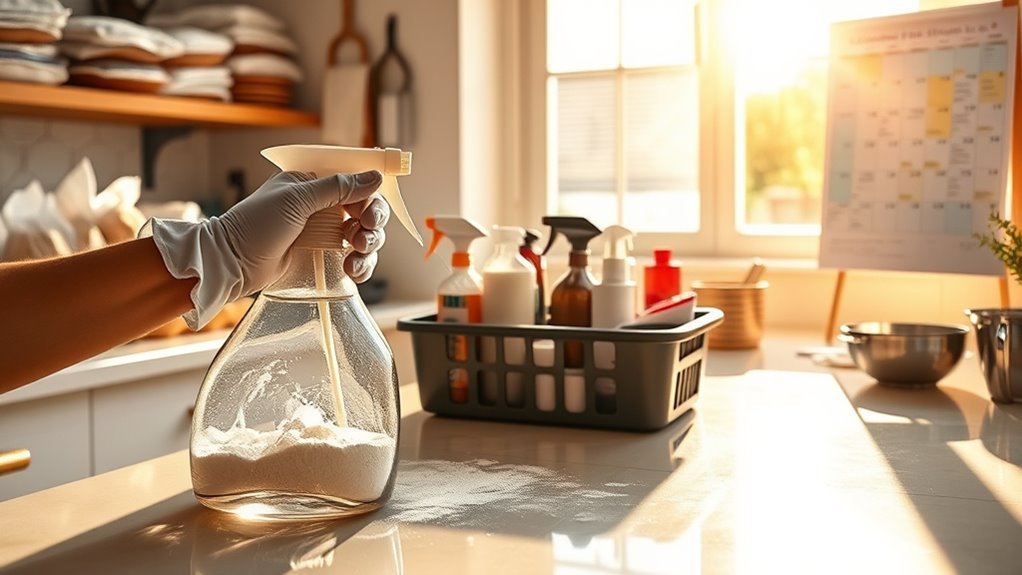
Because a clean workspace directly affects both the quality of your baked goods and your customers’ safety, keeping a regular cleaning schedule is essential. You’ll want to establish a consistent cleaning frequency that fits your baking routine, ensuring no area is overlooked. To make this manageable and free up your time, consider task delegation if you have helpers.
Maintaining a regular cleaning schedule ensures product quality and customer safety while streamlining your baking routine.
Here’s a simple approach to maintain your schedule:
- Daily: Wipe down surfaces, sanitize tools, and sweep floors.
- Weekly: Deep clean ovens, refrigerators, and storage shelves.
- Monthly: Inspect and sanitize less obvious areas like vents and behind appliances.
Häufig gestellte Fragen
How Often Should I Replace My Cleaning Tools in a Home Bakery?
You should replace your cleaning tools regularly to maintain tool effectiveness and keep up with your cleaning frequency. If you’re using them daily, swapping out sponges, brushes, or cloths every one to two weeks helps prevent bacteria buildup. Don’t wait too long—you want your tools working well without slowing you down. Keeping this balance frees you to focus on baking without worrying about cleanliness slipping through the cracks.
Can I Use Natural or Homemade Sanitizers Safely in My Bakery?
You can absolutely use natural sanitizers and homemade solutions in your bakery, but you’ve got to be careful. While these options give you freedom from harsh chemicals, make certain they’re effective against bacteria and viruses. Ingredients like vinegar or hydrogen peroxide can work, but they might not meet strict food safety standards. Always test your homemade sanitizers to verify they’re truly safe and compliant, so your bakery stays both natural and hygienic.
What Are the Signs of Contamination in Baked Goods?
Imagine biting into a muffin only to find it tastes sour and looks fuzzy—that’s a clear sign of contamination. You’ll often notice mold growth or off odors in baked goods when they’re spoiled. These signs mean harmful bacteria or fungi have taken over, so don’t risk your freedom or health by consuming them. Always trust your senses and toss anything that smells weird or shows discoloration.
How Do I Handle Pest Control Without Chemicals in My Kitchen?
You can keep pests at bay by embracing natural pest solutions that respect your kitchen’s freedom. Start by sealing cracks and storing ingredients in airtight containers to deny pests easy access. Using organic pest prevention methods like peppermint oil sprays or diatomaceous earth lets you avoid harsh chemicals. Keeping your space clean and dry also discourages unwanted visitors. These steps help you maintain a safe, chemical-free kitchen where you’re in control.
Are There Specific Certifications Needed for a Home-Based Bakery?
You’ll want to check your local licensing requirements because they vary widely and often include food safety training. While running a home-based bakery gives you freedom, staying compliant is key to avoid fines or shutdowns. Certifications like a food handler’s permit or a cottage food license might be necessary. These guarantee you understand safe food practices, protecting both you and your customers while keeping your business legal and thriving.
